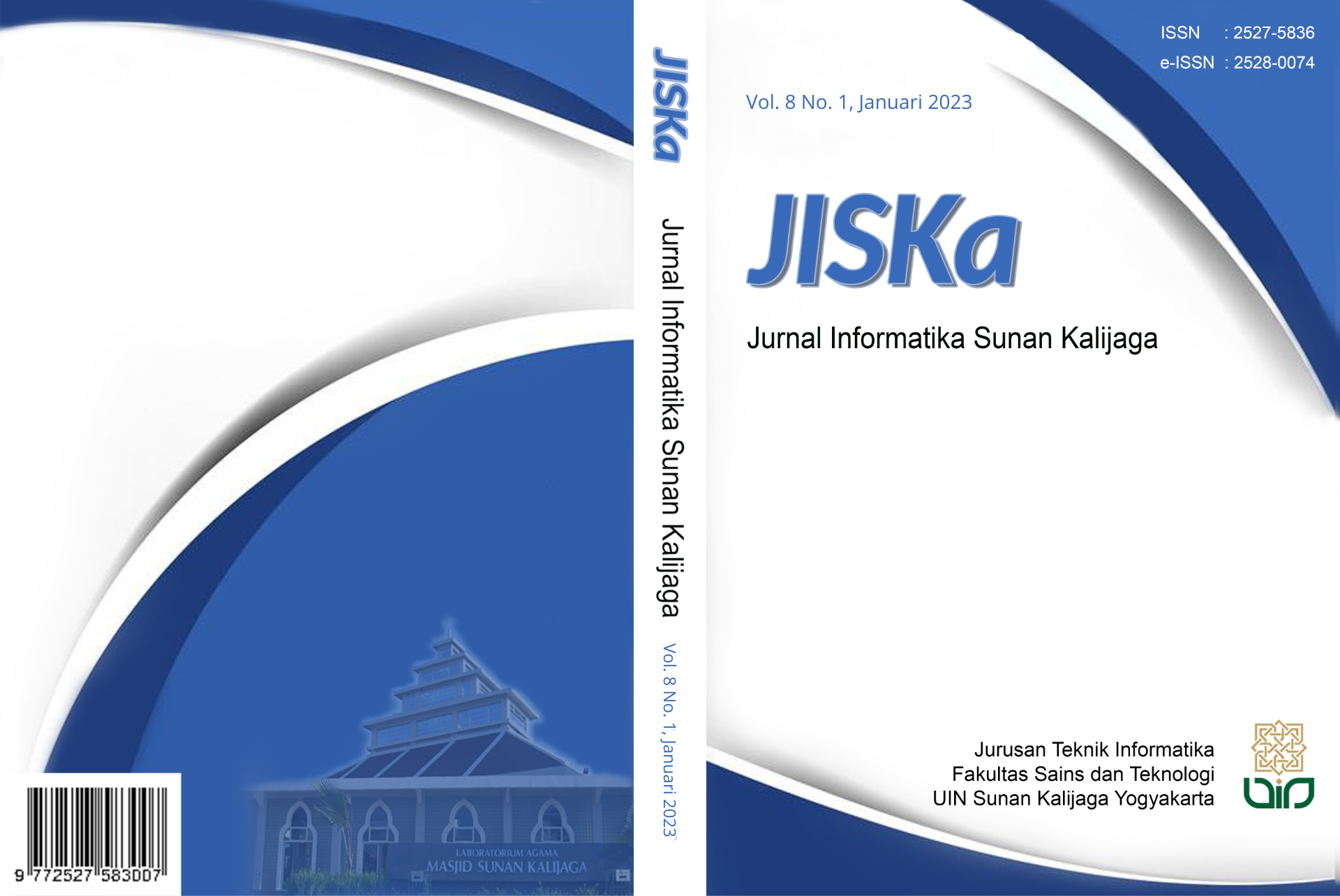Perbandingan Waktu Respon Aplikasi Database NoSQL Elasticsearch dan MongoDB pada Pengujian Operasi CRUD
DOI:
https://doi.org/10.14421/jiska.2023.8.1.22-35Keywords:
Database, NoSQL, Response Time, CRUD Operation Testing, Elasticsearch, MongoDBAbstract
Currently, humans live in an era of data oceans, where the amount of data production is increasing from time to time, which is followed by severe challenges in terms of processing, storing, and analyzing data, especially big data. The increase in the number of large data production can affect the speed of access to the database, effectiveness, and speed of response time in the data processing. Relational databases have been the leading model for data storage, analysis, processing, and retrieval for more than forty years. However, due to the increasing need for large-scale data storage, the scalability and performance of a data processing system, as well as the constant growth of the amount of data, another alternative to databases emerged, namely NoSQL technology. Based on previous studies regarding the comparison of response time and database performance, the average concludes that NoSQL performance is more effective and efficient than relational databases. Based on the implementation and testing, it can be concluded that the NoSQL database application MongoDB is proven to be superior in every command of CRUD tested compared to the Elasticsearch NoSQL database application, where in testing the create data command with a JSON file, the MongoDB database application is 42.5 times faster than the Elasticsearch database application. In testing the command to create data into a database containing different amounts of data, the MongoDB database application is 333.9 times faster than the average response time of the Elasticsearch database application. In testing the read command for data in a database containing different amounts of data, the MongoDB database application is 35.5 times faster than the Elasticsearch database application. In testing the update operation of data in a database containing different amounts of data, the MongoDB database application is 9.8 times faster than the Elasticsearch database application. in testing the delete operation of data in a database containing different amounts of data, the MongoDB database application is 58.9 times faster than the Elasticsearch database application.
References
Ahmed, M. R., Khatun, M. A., Ali, M. A., & Sundaraj, K. (2018). A literature review on NoSQL database for big data processing. International Journal of Engineering & Technology, 7(2), 902–906. https://doi.org/10.14419/IJET.V7I2.12113
Aydoğan, T., İlkuçar, M., & AKCA, M. A. (2016). An Analysis on the Comparison of the Performance and Configuration Features of Big Data Tools Solr and Elasticsearch. International Journal of Intelligent Systems and Applications in Engineering, 4(Special Issue-1), 8–12. https://doi.org/10.18201/ijisae.271328
Amandeep, K., & Singh, D. K. (2016). Performance Evaluation For Crud Operations In NoSQL Databases. I-Manager’s Journal on Cloud Computing, 3(2), 1. https://doi.org/10.26634/jcc.3.2.8164
Bhaswara, F. A., Sarno, R., & Sunaryono, D. (2017). Perbandingan Kemampuan Database NoSQL dan SQL dalam Kasus ERP Retail. Jurnal Teknik ITS, 6(2), A511–A514. https://doi.org/10.12962/J23373539.V6I2.24031
Chauhan, A. (2019). A Review on Various Aspects of MongoDb Databases. International Journal of Engineering Research & Technology, 8(5). https://doi.org/10.17577/IJERTV8IS050031
Damodaran, D., Salim, S., & Vargese, S. M. (2016). Performance Evaluation of MySQL and MongoDB Databases. International Journal on Cybernetics & Informatics (IJCI), 5(2). https://doi.org/10.5121/ijci.2016.5241
Gunawan, R. (2018). Pengukuran Query Respon Time pada NoSQL Database Berbasis Document Stored. Jurnal Siliwangi Seri Sains Dan Teknologi, 4(2). https://jurnal.unsil.ac.id/index.php/jssainstek/article/view/609
Halimi, A., & Sudarmanto, A. (2021). Analisis Perbandingan Kinerja Waktu Respon MySQL 8.0 dan NoSQL MongoDB Mengunakan REST API NodeJS pada Studi Kasus Kelas Online. Jurnal Informatika Wicida, 10(1), 26–33. https://doi.org/10.46984/INF-WCD.1185
Kriestanto, D., & Arnado, A. B. (2017). Implementasi Website Pencarian Kos dengan NoSQL. JIKO (Jurnal Informatika Dan Komputer), 2(2), 103–108. https://doi.org/10.26798/JIKO.V2I2.66
Lourenço, J. R., Cabral, B., Carreiro, P., Vieira, M., & Bernardino, J. (2015). Choosing the right NoSQL database for the job: a quality attribute evaluation. Journal of Big Data, 2(1), 1–26. https://doi.org/10.1186/S40537-015-0025-0/TABLES/2
Modhiya, K. (2021). Introduction to DBMS, RDBMS, and NoSQL Database: NoSQL Database Challenges. SSRN Electronic Journal. https://doi.org/10.2139/SSRN.3798989
Renaldi, R., Santoso, B. C., Natasya, Y., willian, steven, & alfando, fladianand. (2020). Tinjauan Pustaka Sistematis terhadap Basis Data MongoDB. Jurnal Inovasi Informatika, 5(2), 132–142. https://doi.org/10.51170/JII.V5I2.79
Tavares, O. M. I., Rangkoly, S. M., Desy Bawan, S. B., Utami, E., & Mustafa, M. S. (2020). Analisis Perbandingan Performansi Waktu Respons Kueri antara MySQL PHP 7.2.27 dan NoSQL MongoDB. Jurnal Teknologi Informasi, 4(2), 303–313. https://doi.org/10.36294/jurti.v4i2.1695
Wicaksana, I. G. N. A. (2017). Sinkronisasi Basis Data Sql dengan Basis Data Nosql Menggunakan Data Adapter dengan Pendekatan Query Direct Access. Institut Teknologi Sepuluh Nopember.
Yafet, T. T. (2020). Analisis Pemanfaatan NoSQL Database Elasticsearch pada Mesin Pencarian Tokopedia [Universitas Atma Jaya]. http://e-journal.uajy.ac.id/23338/
Downloads
Published
How to Cite
Issue
Section
License
Copyright (c) 2023 Theresia Liana Sinaga, Novrido Charibaldi, Nur Heri Cahyana

This work is licensed under a Creative Commons Attribution-NonCommercial 4.0 International License.
Authors who publish with this journal agree to the following terms as stated in http://creativecommons.org/licenses/by-nc/4.0
a. Authors retain copyright and grant the journal right of first publication with the work simultaneously licensed under a Creative Commons Attribution License that allows others to share the work with an acknowledgement of the work's authorship and initial publication in this journal.
b. Authors are able to enter into separate, additional contractual arrangements for the non-exclusive distribution of the journal's published version of the work (e.g., post it to an institutional repository or publish it in a book), with an acknowledgement of its initial publication in this journal.
c. Authors are permitted and encouraged to post their work online (e.g., in institutional repositories or on their website) prior to and during the submission process, as it can lead to productive exchanges, as well as earlier and greater citation of published work.










